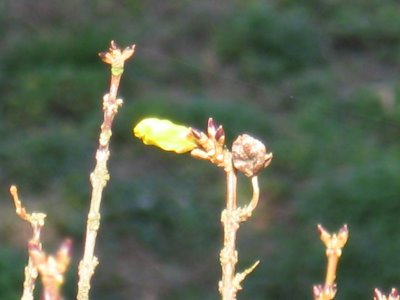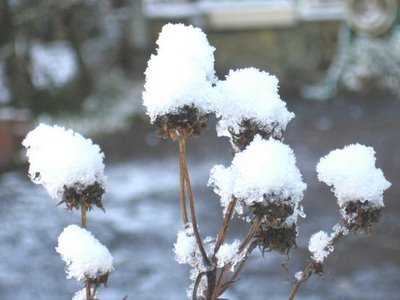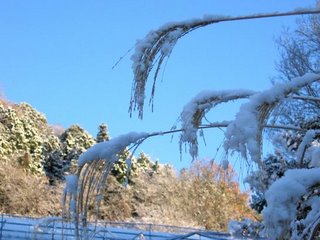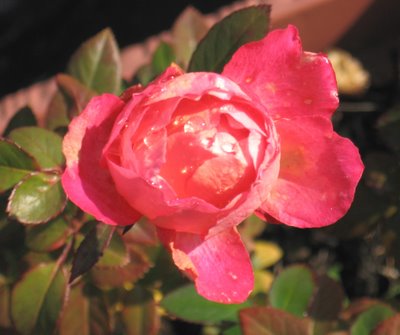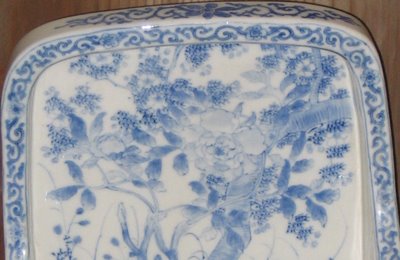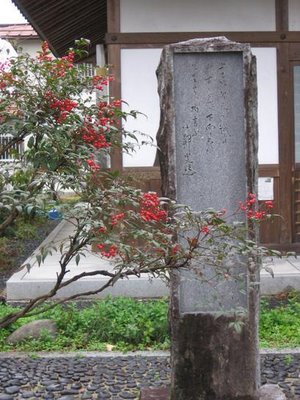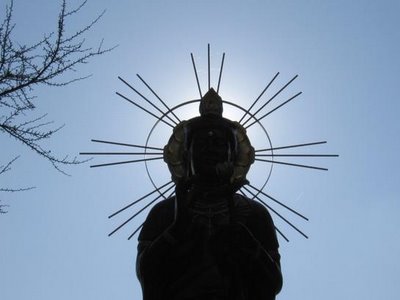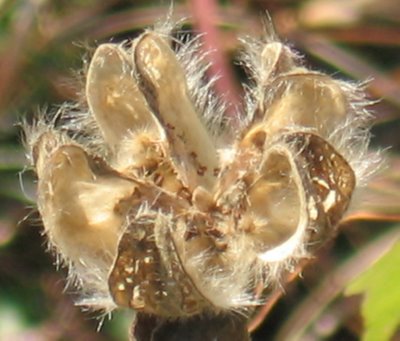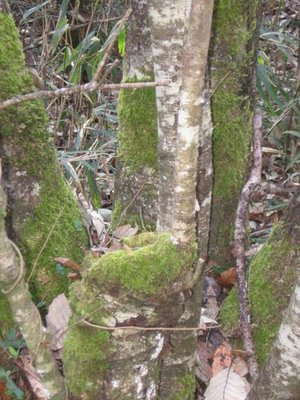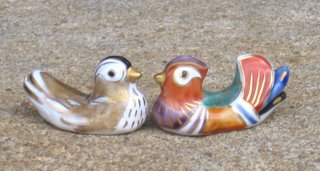[ . BACK to WORLDKIGO TOP . ]
:::::::::::::::::::::::::::::::::::::::::::::::::::::::::::::::::::::::::::::::::::::::::::::::::::::
Do blind people write haiku..?
This question strikes me as rather odd.
Almost like asking :
Can blind people feel happy ?
:::::::::::::::::::::::::::::::::::::::::::::::::::::::::::::::::::::::::::::::::::::::::::::::::::::
kigo for late spring
shakutoo-e 積塔会 (しゃくとうえ)
ceremony for blind people
..... shakutoo-e 石塔会(しゃくとうえ)
shakutoo 石塔(しゃくとう)"stone pagoda"
..... shakutoo 積塔(しゃくとう)
zatoo shakutoo 座頭積塔(ざとうしゃくとう)

Zatoo 座頭 blind minstrel
February 16
Blind people like biwa players (zatoo) meet on Kyoto, Seiju-an 清聚庵 at Shinomiya Kawara 四宮川原 and pray to the Deity of Blind People
Amayo no mikoto 雨夜尊. This is a memorial service to the fourth son (shi no miya) of emperor Ninmyo 仁明天皇 (810 - 50), who was blind. He was a good player of the biwa.
This area of Kyoto is in the "demon direction"
kimon in the northwest of the town. The blind monks and people each one places a stone on top of the other to build a "stone tower" in memory of all the blind people of Japan. Blind monks recice the "Heart Sutra" (Hanya Shinkyo) for 1000 times.
Later they sing and feast.
 source: fukuchi shoten
source: fukuchi shoten
Painting by Yosa Buson
:::::::::::::::::::::::::::::::::::::::::::::::::::::::::::::::::::::::::::::::::::::::::::::::::::::
observance kigo for late summer
zatoo no suzumi 座頭の納涼 (ざとうのすずみ)
blind people enjoying the cool
suzumi no too 涼の塔(すずみのとう) memorial stone pagoda in the coolness
suzumi shakutoo 、涼み積塔(すずみしゃくとう)
On the 19th day of the sixth lunar month, a special memorial service is held for the blind. It is also the memorial day for emperor Kookoo Tennoo 光孝天皇 Koko Tenno, who was the first blind emperor.

光孝天皇 Koko Tenno
830 - 887
The third son of Emperor Ninmyoo.
The Taira clan of
Koko Heishi 光孝平氏 dates back to Emperor Koko.
. SAIJIKI ... Ceremonies and Festivals
:::::::::::::::::::::::::::::::::::::::::::::::::::::::::::::::::::::::::::::::::::::::::::::::::::::
topic for haiku
blind woman, goze 女盲, ごぜ, ゴゼ, 瞽女
blind nun, ama goze 尼ごぜ、あまごぜ
From the Edo period (1600-1868) goze organized themselves in a number of ways.
. blind woman from Echigo, Echigo goze 越後女盲 .
越後ごぜ , 「瞽女(ごぜ)」
海御前(あまごぜ)
:::::::::::::::::::::::::::::::::::::::::::::::::::::::::::::::::::::::::::::::::::::::::::::::::::::
a warm smile on the
blind man's face -
summer sunshine
autumn sunset -
the blind man reaches
for his dog
the tearful eyes
of a blind woman -
winter sun
cheerful laughter
in the blind kid's school -
spring sunshine
:::::::::::::::::::::::::::::::::::::::::::::::::::::::::::::::::::::::::::::::::::::::::::::::::::::
 source : Jules Bastien-Lepage
the look
source : Jules Bastien-Lepage
the look
in the blind beggar's eyes -
autumn sunset
Gabi Greve
:::::::::::::::::::::::::::::::::::::::::::::::::::::::::::::::::::::::::::::::::::::::::::::::::::::
雉なくや座頭が橋を這ふ時に
kiji naku ya zatoo ga hashi o hau toki ni
a pheasant cries out
as a blind man crawls
across the bridge
Tr. Chris Drake
This hokku is from the 2nd month (March) of 1818, when Issa was traveling around to various villages and towns near his hometown. In his diary at this time Issa has three hokku in a row about pheasants, of which the above hokku is the second. All three seem to be serious and based on close observation.
In the hokku, the pheasant has noticed something it feels to be important or dangerous, and it turns out to be a blind man (or woman -- the gender is not given) crawling across a nearby bridge. Perhaps it is a narrow bridge with no railing, or perhaps there is ice or cold rain on the bridge, making it slippery. In any case, the blind man decides it would be dangerous to try to walk across, and he gets down on his hands and knees and crawls across instead. The pheasant probably doesn't understand what's happening, but Issa seems impressed by the way it senses something is unusual or wrong.
The pheasant isn't warning of danger to itself, but it might be warning of danger it vaguely senses to another creature. Issa understands what's happening, and he may be using the pheasant's loud, sharp cry to suggest his own momentary worry for the safety of the blind man. There's no hint in the wording of the hokku that Issa is making fun of the blind man or comparing blindness to any form of benightedness or spiritual lack. After all, imperfection is the human condition, and Amida accepts sincere humans in spite of their weaknesses. Issa often compares himself to a beggar and calls himself a fool, and he is surely sympathizing with the man who is forced to crawl in order to stay alive. Perhaps the hokku is intended as a human form of crying out.
The word zatou literally means 'group leader' and is the lowest of four ranks in the organization created by blind performers in the Edo period. In addition to chanting ballads and plays, telling stories, and singing and composing songs to the accompaniment of various instruments, blind professionals were active in many fields, especially in acupuncture and massage. The term zatou can also simply mean a blind person.
Chris Drake
. WKD : Kobayashi Issa 小林一茶 in Edo .
座頭坊や赤椀で蠅追ひながら
zato boo ya aka wan de hae oi-nagara
the blind priest
with his red bowl...
shooing flies
Tr. David Lanoue
 Two Blind Men Crossing a Log Bridge
. Hakuin Ekaku (白隠 慧鶴 Hakuin Ekaku) .
Two Blind Men Crossing a Log Bridge
. Hakuin Ekaku (白隠 慧鶴 Hakuin Ekaku) .
(1686-1769 or 1685-1768)
:::::::::::::::::::::::::::::::::::::::::::::::::::::::::::::::::::::::::::::::::::::::::::::::::::::
stop sign . . .
the blind veteran waves
a dozen roses
Don Baird
:::::::::::::::::::::::::::::::::::::::::::::::::::::::::::::::::::::::::::::::::::::::::::::::::::::
Close your eyes and spend one whole day like that!
Then you will know the answer, I hope.
WKD : World Handicap Day .. Black Day for the Blind
Haiku Topics in the World Kigo Database
:::::::::::::::::::::::::::::::::::::::::::::::::::::::::::::::::::::::::::::::::::::::::::::::::::::
bedtime story
my grandfathers' fingers
touching the Braille
- Shared by John Wisdom -
Joys of Japan, 2012
:::::::::::::::::::::::::::::::::::::::::::::::::::::::::::::::::::::::::::::::::::::::::::::::::::::
Blind People and Elephant 盲人と象 - Hokusai
 O how they cling and wrangle, some who claim
O how they cling and wrangle, some who claim
For preacher and monk the honored name!
For, quarreling, each to his view they cling.
Such folk see only one side of a thing.
Buddha
. Katsushika Hokusai (1760-1849) 葛飾北斎 .
:::::::::::::::::::::::::::::::::::::::::::::::::::::::::::::::::::::::::::::::::::::::::::::::::::::
座頭かと人に見られて月見哉 / zatō
zatoo ka to hito ni mirarete tsukimi kana
I appear to people
like a blind man
watching the moon . . .
Written in 1686, Basho age 43. 貞亨3年八月十五夜
Basho was wearing the outfit of a monk, often used by blind poeple.
The cut marker KANA is at the end of line 3.
zatoo was one of the four grades of the Biwa Hooshi singers 琵琶法師:
kengyoo 検校 - bettoo 別当 - kootoo 勾当 - zatoo 座頭
During the Edo period it was also used for other kind of blind people.
. Matsuo Basho 松尾芭蕉 - Archives of the WKD .
. tsukimi 月見 つきみ moon viewing .
- quote -
The Story of the Blind Bankers of Edo Era Japan
Centuries ago, members of the Todoza saw no reason why being blind should keep them from being rich
By Cezary Jan Strusiewicz
- source : tokyoweekender.com/2021 ... -
:::::::::::::::::::::::::::::::::::::::::::::::::::::::::::::::::::::::::::::::::::::::::::::::::::::
. Pagoda and Stone Pagoda - Topics for Haiku
[ . BACK to WORLDKIGO TOP . ]
[ . BACK to DARUMA MUSEUM TOP . ]
:::::::::::::::::::::::::::::::::::::::::::::::::::::::::::::::::::::::::::::::::::::::::::::::::::::


